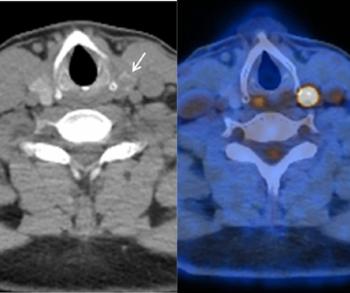
Fibroid embolization agent influences treatment result
A controversy simmering since last year's meeting of the Society of Interventional Radiology resurfaced during the RSNA meeting when Yale researchers presented evidence that a particular type of polyvinyl alcohol particles, used to embolize bleeding uterine fibroids, is less effective than other products. They concluded that the use of Contour SE could lead to greater fibroid recurrence and repeat embolization procedures.
A controversy simmering since last year's meeting of the Society of Interventional Radiology resurfaced during the RSNA meeting when Yale researchers presented evidence that a particular type of polyvinyl alcohol particles, used to embolize bleeding uterine fibroids, is less effective than other products. They concluded that the use of Contour SE could lead to greater fibroid recurrence and repeat embolization procedures.
Using contrast-enhanced MR scans, the Yale researchers compared long-term results, including recurrence of fibroids and fibroid-related symptoms, for uterine arterial embolization (UAE) using three different agents:
- Contour PVA (classic polyvinyl alcohol particles), Boston Scientific;
- Contour SE (spherical PVA or sPVA), Boston Scientific; and
- Embosphere (gelatin microspheres), Biosphere Medical.
Contour SE proved significantly less effective than either gelatin microspheres (GM) or classic polyvinyl alcohol particles, according to the study findings.
"All embolic agents are not created equal, even though they are all FDA-approved. Practitioners performing UAE should avoid using spherical PVA and instead use gelatin microspheres or traditional PVA," said Dr. Michael Tal, director of interventional radiology research at Yale.
Traditionally, the test of an embolic agent's effectiveness has been improvement in fibroid-related symptoms and quality of life following UAE, as well as reduction in fibroid volume on standard MRI. But researchers are beginning to use the more demanding yardstick of contrast-enhanced MRI, which reveals residual perfusion in fibroids post-UAE. The goal of UAE is to infarct fibroids. If MRI shows they are only partially infarcted, and portions still have a blood supply, it is likely that they will recur.
In studies reported at the 2005 SIR meeting, Contour SE demonstrated good initial results but ultimately yielded a higher incidence of fibroid recurrence on contrast-enhanced MRI. The studies suggested that particle size was the difference.
A 2004 protocol devised by Boston Scientific called for an sPVA particle size of 500 to 700 microg, 700 to 900 microg, or 900 to 1200 microg. The physician should embolize both uterine arteries to complete stasis, defined as stoppage of the blood flow in the main uterine artery for 10 cardiac beats. The 2004 protocol recommends that users wait for five minutes after stasis to look for evidence of particle redistribution, according to the company.
But in 2005, following the release of new research with contrast-enhanced MRI, Boston Scientific suggested a revised UAE protocol, calling for sPVA with larger microspheres (700 to 900 microg or 900 to 1200 microg). Instructions about embolization to stasis remain unchanged.
It's questionable whether traditional UAE success measures of symptom relief and improvement of quality of life should now be replaced, said Scott Pisarczyk, vice president of marketing for oncology at Boston Scientific.
"There is debate about what is the true measure of success-if the patient feels better and the size of her fibroids has decreased, or the results of contrast-enhanced MR," he said.
If practitioners want to use contrast-enhanced MRI as a determinant of success, they should follow the revised protocol, he said. A study presented at the 2005 SIR meeting by French authors and sponsored by Boston Scientific showed that use of the larger particles and embolization to stasis resulted in an 83% rate of complete fibroid infarction.
Some experts say the new protocol is not practical. To be successful, a practitioner must force the larger Contour SE particles through a microcatheter with a luminal diameter smaller than the nominal size of the particles, said Dr. Robert Worthington-Kirsch, founder of Image Guided Surgery Associates in Philadelphia.
"I believe that Contour SE should not be used for UAE. Although there is some (not conclusive) evidence that UAE can be effective if performed using the revised protocol, that protocol is technically difficult to achieve. UAE is far easier to accomplish and has better documented results with hydrogel microspheres, so why should anyone bother with Contour SE?" Worthington-Kirsch said.
The Yale study involved 101 patients embolized with either PVA (300 to 500 microg), GM (500 to 700 microg), or sPVA (500 to 700 microg). Contrast-enhanced MR findings were correlated with quality of life survey results.
Incomplete infarction, as gauged by residual enhancement on MR, occurred in 75% of sPVA cases, 41% of PVA cases, and only 22% of GM cases. The differences between sPVA and the other two agents were statistically significant, while the difference between GM and PVA was not.
Patients treated using Contour SE were at higher risk of residual enhancement than those who received Contour PVA or Embosphere, according to medical student Jorge Galvez, who presented the results at the RSNA and won a trainee research prize for the work. However, differences in symptom recurrence, as reported on the patient survey, were not statistically significant for the three agents.
Tal, who supervised the study, said that while Contour SE proved less effective based on contrast-enhanced MR, the team is now evaluating another sPVA compound. That agent, distributed by Terumo Medical, may yield results comparable to GM, he said.
Classic PVA particles, which have been used effectively for decades, are now obsolete according to Worthington-Kirsch. They may not reliably provide complete vessel occlusion and should not be used for UAE.
"It (GM) works well and is easy to use. In my opinion, this is the current standard by which other materials must be measured," he said.
Newsletter
Stay at the forefront of radiology with the Diagnostic Imaging newsletter, delivering the latest news, clinical insights, and imaging advancements for today’s radiologists.




























